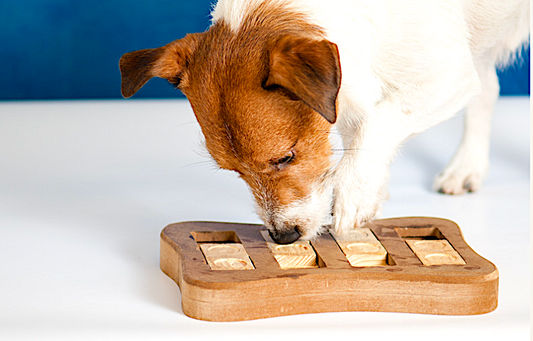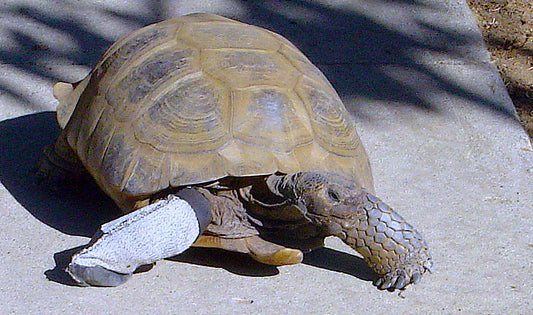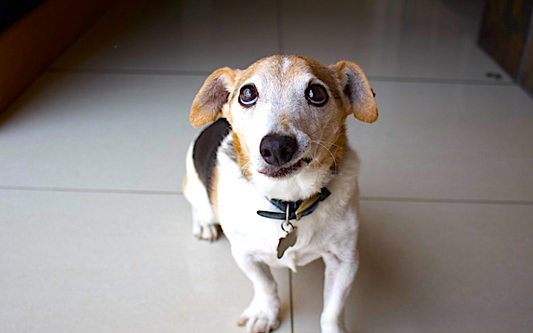We all have different breaking points as dog owners. I’m currently fostering a dog who is really barky – whose immediate, reflexive response to every new stimuli is to let loose with an ear-piercing BARK! – and this is proving to be my Achilles heel.
A friend adopted this dog from Craigslist, knowing full well that she had to travel out of town for a month two weeks after adopting the dog, whom she named Sophie. The dog sounded like it might be a good match for her, so I offered to board Sophie for the month when my friend had to leave town – but by the time her first two weeks with the dog were up, my friend was already convinced that Sophie was not the right dog for her. So, now I’m fostering (rather than boarding) Sophie, and we’re looking for the right home for her.
If it sounds flaky, wanting to rehome a dog after two weeks of taking possession of her, consider this: Sophie was turned over to my friend in a poor state, exceedingly thin, ungroomed (Sophie is a Maltese/Poodle-mix, with a coat that requires daily care and monthly clipping), and – get this – pregnant. (Ah, that helps explain why the family with “not enough time for a dog” was in such a rush to rehome Sophie.) Even though my friend was, from their first day together, having doubts about whether she and Sophie were compatible, given Sophie’s neglected condition, she never considered bringing the dog back to her previous family, and willingly paid for grooming and spay surgery, knowing both should be done before the little dog is rehomed.
Fortunately, my friend knew Sophie was intact and she had made an appointment for spay surgery before she even went to meet the adorable little dog, so when the vet detected the pregnancy just prior to surgery, it was early enough to abort the pups of unknown parentage and go through with the spay. (Sad, but better than potentially having to pay for an emergency C-section on the small, skinny dog and spend a couple of months caring for and then trying to find homes for puppies.)
I met Sophie a few days after my friend brought her home, and was impressed by how exceedingly trainable she was. I showed my friend how to increase her name recognition, in order to bring her attention back from things she wanted to bark at. She already had a solid “sit,” and I taught her a “down” cue within just a few minutes. I met my friend for a walk on a local trail, and was thrilled to see how good Sophie was as a walking companion. My friend had been taking her for off-leash trail walks already, which made me quite nervous (I advise people to wait for weeks of bonding before trying any off-leash time in unfenced areas). But Sophie stayed with us like she had been walking with my dogs forever. Though she clearly enjoyed exploring and sniffing things along the trail, she never got more than 30 feet ahead of us and would turn around and “check in” frequently.
Over the course of the two weeks Sophie was with my friend, we spoke nearly daily. I offered her lots of advice on the issues she was having with Sophie, but by the time she was due to leave town, Sophie had chased her elderly cat a few times and had a few “accidents” in the house, and Sophie’s relentless attention-seeking had proved to be her Achilles heel. In fact, by that time, my friend was pretty well convinced she shouldn’t have a dog at all.
My friend’s complaints about Sophie:
- Barking at every passerby
- Going potty in the house, and not at all outside
- Chasing/lunging at the cat
- Barking and screaming hysterically when crated or left alone behind a baby gate in another room
- Being hysterical in the car, unless on the driver’s lap while in motion (very dangerous!). If the car stops, she starts spinning and barking in anticipation
- And, my friend said, “I can’t have a moment to myself! She’s constantly wanting to be held or petted. She demands attention from me at every moment.”

I wasn’t particularly worried about any of these behaviors. My experience with foster dogs is that it doesn’t take long for not-very-enjoyable, disruptive dogs to transform into well-behaved and fun dogs once they have an opportunity to experience a structured and well-managed environment. The key is giving them few chances to practice unwanted behaviors, lots of exercise, and, most of all, lots of reinforcement for every bit of the kind of calm behavior that most dog owners want to see around the house.
It also helps immensely to have already well-behaved, calm dogs who can help model the behaviors I want to see and demonstrate how to win rewards (of treats, attention, praise, and petting) based on my everyday expectations.
I’ve been providing all of this to Sophie for the past three weeks, in spades. I don’t have a cat, so the cat-chasing is the one behavior we haven’t had an opportunity to work on, but she’s improved soooo much. In three weeks, I’ve gone from secretly agreeing with my friend that this dog is just too much, to genuinely enjoying her. She’s a delight on the trail, she’s a fetching fool (good competition for my own fetching fool of a dog, 6-year-old pit-mix Woody), her zoomies are hilarious, and she’s very sweet and affectionate.
To manage her attention-seeking, which my friend found most annoying, I put an exercise pen around my desk so I can work without her jumping up on and pawing at me, and gave her a variety of chewies and toys to occupy herself with. At first, she would jump up on the pen and whine and bark for attention, so I started by marking and rewarding her brief moments of quiet – and by increasing the value of the food-stuffed toys and chewies I gave her. I tried to frequently “catch her doing something right,” and praising her when she was entertaining herself – and offset all of this quiet time with a daily off-leash walk and frequent breaks to go outside and throw a ball for her. We even play fetch at night with a light-up ball! I was able to take down the exercise pen after just a few days, and she’s learned that I will absolutely give her attention and affection at various points throughout the day, but not when she demands it whining and jumping on me.

I managed her car behavior with a harness and a tether that clips into the back seat seatbelt receptacle. By day three of daily short rides in the car (to the trails and home) she realized there was no getting out of the arrangement and began riding very calmly in the car. One exception: She still yodels with excitement when she recognizes our impeding stop at one of our trail-walking spots. With all of the other issues we’re working on, that battle is not worth fighting (to me).
As regards potty training: I started out by treating her like a tiny puppy, taking her out at least every hour and patiently waiting outside with her every time until she eliminated. If she never did, after 10 minutes or so of cooling our heels outside, I’d pop her into a crate for another half-hour or so, and then try again. For the first five days she had no house training lapses. Of course, then I got overconfident and less vigilant, and she sneaked a few pee puddles in my bedroom when I was busy in the kitchen. Since then, I have learned her schedule, and she’s learned the cue I’m using to encourage her to eliminate quickly for a reward, and she hasn’t had an “accident” in my house or office for 10 days or more.
Sophie’s separation anxiety was not severe – though it certainly seemed so to my friend, who wasn’t at all prepared to spend copious amounts of time working on that behavior. Mostly, this consists of V E R Y S L O W L Y increasing the amount of time that you step away from the anxious dog, desensitizing her to the sensation of being alone. Since I work at home, I can work on that all day, every day!
I let her shadow me for the first few days, including every trip to the bathroom, every trip to the mailbox or my car, and every trip back and forth from my office building (about 100 feet from my house), until she understood the lay of the land. Within about a week she would elect to keep working on her peanut butter Kong in the living room while I went to the bathroom without her. Within about two weeks she could wait in my office without screaming while I went to the house to get a cup of coffee without her.

It helped immensely that Sophie really enjoys being outdoors, and the weather has been so mild – warm and spring-like – that I’ve been able to leave my office door open while I work, giving her the opportunity to leave me to go outside and explore my fenced two acres. I have to give that a lot of credit for her ever-increasing confidence with being physically separated.
On our three-week anniversary, I pushed the envelope by leaving her in my office while going out for about 6 hours in the evening, and she was calm when I got home. Hurray! I think that if her adopter can do something similar to this, her anxiety about being left alone will resolve in a reasonable amount of time. (For more about dealing with separation anxiety, see “Amicable Separation,” WDJ June 2020; and “Separation Anxiety in Dogs,” WDJ October 2016.)
The last thing we’re working on is the barking. She doesn’t bark that much during play, and even if she did, I regard that as a normal and natural thing. Her biggest trigger for barking is people walking down the road past our property; she’s constantly scanning for these “intruders.” Unfortunately, she considers the neighbor’s property to be worthy of surveillance, too. If she’s outside for a while by herself, she is prone to standing at the fence line that separates my property with my closest neighbor, and barking anytime she sees a person, car, cat, or dog move. It’s a multi-generation household, so there is a fair amount of movement to be seen.

I’ve countered this surveillance by calling her and richly rewarding her with high-value treats every time she comes back to me. A couple of times, she’s looked at me and made the choice to just stay there barking; in those instances, I’ve walked to her, praised her for letting me approach and pet her, picked her up and carried her back into my office. I don’t scold her, but she loses outdoor privileges for a while. After three weeks of this, she’s figured out the consequences (loss of outdoor fun), so now she comes running when I call, takes her treats and then (most of the time) will choose to do something else with her outdoor time.
The barking that I find hardest to deal with calmly is Sophie’s completely out-of-the-blue, single, loud, sharp, shrill alarm bark. When I’m concentrating at my computer, and she’s been asleep or absorbed in chewing a toy, and suddenly she lets loose one of these BARK! noises – I have to admit that my immediate reaction is to bark back. “HOLY CRAP! NO!” I’ve shouted at her as I unstick myself from the ceiling – even as I start admonishing myself for such an ineffective strategy.
Intellectually I understand that yelling back at her is a strategy that’s bound to worsen this sort of barking, as it can’t help but to increase the anxiety she feels about whatever made her bark in the first place, but I’m only human! And it’s time to go review some of the articles about dealing with barking that we’ve run in the past (including “Why Dogs Bark and How to Stop Them,” March 2017, and “Bark-a-holics Not Very Anonymous,” October 2018.
Wish me luck!
The post Fostering Adolescent Dogs Takes Patience and Experience appeared first on Whole Dog Journal.





